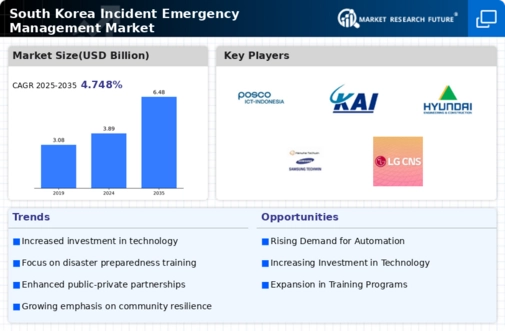Regulatory Compliance and Standards
The incident emergency-management market in South Korea is increasingly influenced by stringent regulatory frameworks and compliance requirements. Government agencies are mandating adherence to specific safety and emergency protocols, which necessitates the adoption of advanced management systems. This regulatory landscape compels organizations to invest in technologies that ensure compliance, thereby driving market growth. For instance, the South Korean government has implemented various laws aimed at enhancing disaster response capabilities, which has led to a projected market growth rate of approximately 8.5% annually. As organizations strive to meet these regulations, the demand for innovative solutions in the incident emergency-management market is expected to rise significantly.
Investment in Infrastructure Resilience
The need for resilient infrastructure is a critical driver in the incident emergency-management market. South Korea's urbanization and industrialization have heightened the vulnerability of infrastructure to various incidents, including natural disasters. Consequently, there is a growing emphasis on enhancing the resilience of critical infrastructure, which includes transportation, utilities, and communication systems. The government has allocated substantial funding, estimated at $1 billion, towards improving infrastructure resilience over the next five years. This investment is likely to stimulate demand for advanced emergency management solutions, as organizations seek to protect their assets and ensure continuity of operations in the face of potential incidents.
Increased Frequency of Natural Disasters
The rising frequency of natural disasters is a significant driver of the incident emergency-management market. South Korea has experienced an uptick in incidents such as typhoons, floods, and earthquakes, prompting a reevaluation of emergency preparedness strategies. This trend has led to increased investments in emergency management systems and technologies. According to recent data, the economic impact of natural disasters in South Korea has reached approximately $2 billion annually, underscoring the urgent need for effective incident management solutions. As the threat landscape evolves, organizations are likely to prioritize investments in the incident emergency-management market to mitigate risks and enhance their response capabilities.
Public Awareness and Community Engagement
Public awareness campaigns and community engagement initiatives are pivotal in shaping the incident emergency-management market. In South Korea, there is a concerted effort to educate citizens about emergency preparedness and response strategies. This heightened awareness is fostering a culture of preparedness, which in turn drives demand for training programs and emergency management tools. Surveys indicate that approximately 70% of the population is now aware of emergency protocols, reflecting a significant increase in public engagement. As communities become more proactive in their approach to emergencies, the incident emergency-management market is likely to see a corresponding rise in the adoption of relevant technologies and services.
Technological Advancements in Communication
Advancements in communication technologies are transforming the incident emergency-management market. The integration of real-time communication tools and mobile applications is enhancing the efficiency of emergency response efforts. In South Korea, the proliferation of smartphones and digital platforms has enabled quicker dissemination of information during incidents, thereby improving situational awareness. The market for communication technologies within the incident emergency-management sector is projected to grow by 12% annually, driven by the need for effective coordination among emergency responders. As organizations increasingly rely on these technologies, the overall effectiveness of incident management is expected to improve significantly.
















Leave a Comment